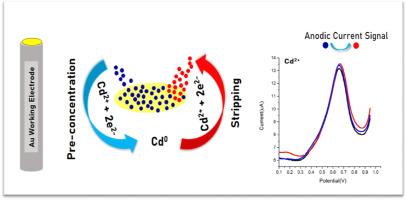一种先进、灵敏的镉检测方法,采用阳极溶出伏安法,经化学计量方法验证
IF 3.4
4区 化学
Q2 CHEMISTRY, MULTIDISCIPLINARY
引用次数: 0
摘要
背景与意义镉(Cd2+)是一种剧毒重金属污染物,对人类健康和环境构成重大威胁。它广泛存在于各行各业,包括采矿、电镀和电池制造,导致了土壤、水和空气的污染。由于镉暴露对健康的严重影响,准确灵敏的检测对于环境监测和公众健康保护至关重要。及早发现可以及时干预,减轻污染,防止对健康造成不利影响。结果本研究提出了一种新的电化学传感方案,利用阳极溶出伏安法(ASV)与数学建模-化学计量优化相结合,用于Cd2+检测。通过优化电化学参数并采用偏最小二乘回归(PLSR)进行验证,该方法具有良好的灵敏度和选择性。优化后的ASV-PLSR方法在10 ~ 50 ppb的线性浓度范围内,灵敏度为0.281 μAppb-1,检出限为0.63 ppb。PLSR模型有效地区分了Cd2+信号与背景干扰,保证了检测的准确性和可靠性。所开发的传感方案具有良好的稳定性和鲁棒性,适合于环境监测的实际应用。该研究为环境分析领域提供了一种灵敏、选择性和可靠的Cd2+检测方法。与传统方法相比,ASV和PLSR的结合具有显著的优势,能够准确和早期地检测Cd2+污染。这一进展有可能改善环境监测和公共卫生安全。本文章由计算机程序翻译,如有差异,请以英文原文为准。

An advanced and sensitive cadmium detection using anodic stripping voltammetry validated by a chemometric approach
Background and significance
Cadmium (Cd2+) is a highly toxic heavy metal contaminant that poses a significant threat to human health and the environment. Its widespread presence in various industries, including mining, electroplating, and battery manufacturing, has led to its contamination of soil, water, and air. Due to the serious health implications of cadmium exposure, accurate and sensitive detection is crucial for environmental monitoring and public health protection. Early detection allows for timely intervention to mitigate contamination and prevent adverse health effects.
Results
This study presents a novel electrochemical sensing protocol for Cd2+ detection using Anodic Stripping Voltammetry (ASV) coupled with mathematical modelling-chemometric optimisation. By carefully optimising the electrochemical parameters and employing Partial Least Squares Regression (PLSR) for validation, the proposed method achieved remarkable sensitivity and selectivity. The optimized ASV-PLSR method demonstrated a high sensitivity of 0.281 μAppb-1 with a low detection limit of 0.63 ppb within a linear concentration range of 10–50 ppb. The PLSR model effectively discriminated Cd2+ signals from background interferences, ensuring accurate and reliable detection. The developed sensing scheme exhibited excellent stability and robustness, making it suitable for practical applications in environmental monitoring.
Contribution
The research contributes to the field of environmental analysis by providing a sensitive, selective, and reliable method for Cd2+ detection. The combination of ASV and PLSR offers a significant advantage over conventional methods, enabling accurate and early detection of Cd2+ contamination. This advancement has the potential to improve environmental monitoring and public health safety.
求助全文
通过发布文献求助,成功后即可免费获取论文全文。
去求助
来源期刊
CiteScore
3.50
自引率
7.70%
发文量
492
审稿时长
3-8 weeks
期刊介绍:
The Journal of the Indian Chemical Society publishes original, fundamental, theorical, experimental research work of highest quality in all areas of chemistry, biochemistry, medicinal chemistry, electrochemistry, agrochemistry, chemical engineering and technology, food chemistry, environmental chemistry, etc.

 求助内容:
求助内容: 应助结果提醒方式:
应助结果提醒方式:


